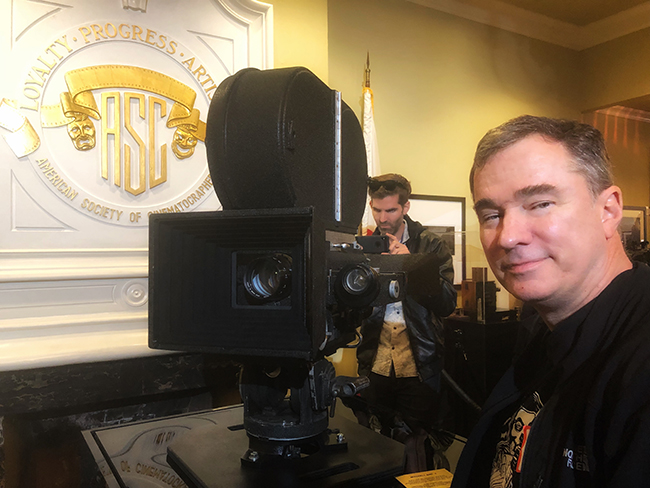An IronOrbit Blog – By John McMahon
This crossroads we find ourselves at is inspiring, scary, and uncertain all at the same time. As University leaders struggle to find ways to recover, they must also find ways to teach that are more aligned with what we know about human cognitive architecture and less about tradition. Holding onto tradition stifles many students, but It also holds educators back from seeing possibilities that can arise from bringing methodologies together with technological advancements.
In a May 5, 2020 HBR article – Higher Ed Needs a Long-Term Plan for Virtual Learning, James DeVaney, Gideon Shimshon, Matthew Rascoff,
and Jeff Maggioncalda acknowledge the staggering impact that Covid-19 has had on the global education system and the skyrocketing
demand for online learning programs. To be sure, these emergency remote teaching applications are stop-gap measures only. “As the
emergency subsides but normal fails to return, higher ed institutions need to do more. There’s a good likelihood that virtual learning, in some
capacity, will need to be a part of education for the foreseeable future.
Higher education institutions need a response framework that looks beyond the immediate actions. They have to prepare for an intermediate
period of transition and begin future-proofing their institutions. Universities need to provide their own online content from their own faculty.
Many professors have never designed nor delivered a course online, and that’s the challenge – rethinking the whole approach to teaching.
We will come back to this point later.
First, we will look at another challenge that universities face.
The HBR article points out that if the coronavirus pandemic occurred a decade earlier, universities would have been devastated. Today we
have cloud computing, broadband access, and widespread smartphone adoption to help organizations adapt quickly to almost any situation
as long as the Internet is stable. But not all educational institutions are equipped with state-of-the-art technology.
Advanced institutions like the University of Michigan, Imperial College London, and Duke University have already invested time and money
in pioneering digital education strategies. Their faculties have been accustomed to online teaching for years. For example, in September
2002, the MIT Open Course Ware proof-of-concept pilot site opened to the public, offering 32 courses. In September 2003, MIT Open Course
Ware published its 500th course, including some courses with complete streaming video lectures. By September 2004, 900 MIT courses
were available online.

“Institutions that lack the necessary prerequisites of online
learning and remote teaching face a daunting challenge.”
Many education leaders believe that IT infrastructure issues must be addressed before any real progress can be made towards virtual learning. In the March 31, 2020 HBR article What the Shift to Virtual Learning Could Mean for the Future of Higher Ed, Vijay Govindarjan and Anup Srivastava urge educators to collect data and pay attention to three questions:
- Do students need a four-year residential experience?
- What improvements are required in IT infrastructure to make it more suitable for online education?
- What training efforts are required for faculty and students to facilitate changes in mindsets and behaviors?
Regarding the second question – What improvements are required in IT infrastructure – Govindarjan and Sirvastava point out that online
settings amplify the digital divide. Some students have access to the latest model laptops, better bandwidths and more powerful Wi-Fi
connections, while others don’t. “Digital divide also exists among universities, which will become apparent in the current experiment. Top
private universities have better IT infrastructure and higher IT support staff ratio for each faculty compared to budget-starved public
universities.”
And the question of IT infrastructure doesn’t stop at digital equality. “Software for conference calls may be a good start, but it can’t handle
some key functionalities such as accommodating large class sizes while also providing a personalized experience. Even in a
1,000-plus-student classroom, an instructor can sense if students are absorbing concepts, and will change the pace of the teaching
accordingly. Instructors and students must note and should discuss their pain points and facilitate and demand technological development
in those areas.”
Now that we have explored the IT infrastructure for online education, let’s return to our original challenge – the traditional old school (pun
intended) approach to teaching.

There has to be whole new structure to how material is presented. Learning methodologies have to be reconsidered. In the original Star Trek series,
Captain Kirk is often seen playing 3-Dimensional Chess with his second-command Mr. Spock. Invariably, Captain Kirk loses and the series is filled with Spock commenting about people’s actions, indicating 2-dimensional thinking. They’re not considering the X,Y and Z axes of outer space. It seems an apt metaphor for the way educators are trying to solve the puzzle. They know they have to transform, but how? How does a traditional university mindset transition from an in-person classroom environment to an online or hybrid
model?
Educators will have to expand their views and ideas of how to present information. They must walk into another environment where there are more options and several possible integrations. Not just adding multiple activities, re-imagining seminars, and fine
tuning how they teach courses online, but also dramatically rethinking the whole approach. Take a look at the technological mix of simulators
and the emerging science of augmented and virtual reality.
Imagining Three-Dimensional Education in the New Normal
Curtis Bonk, Indiana University’s Professor of Education and author of The World is Open: How Web Technology is Revolutionizing Education,
tells us that, “This is a revolution. Education doesn’t have to take place with the teacher front and center and students sitting in rows. It can
take place outside, under a tree branch, on a boat or plane, in a grocery store or while hiking, if you have an Internet connection.”
Imperial College London is one of the institutions that was set up with cloud-based, distance education systems before the pandemic started.
They are certainly in a better position now because of it. They’re using the phrase “multi-mode teaching” to describe how they are
approaching this coming fall semester. Others are using the term “blended learning” to describe the same hybrid approach to the
online/on-premise teaching environment.
“Our multi-mode learning in the Autumn term will be a change from the traditional university experience, but we are confident it will be an
exciting, innovative and most importantly safe approach for our students and staff in these uncertain times. It will also enable students to
graduate from the College as highly skilled individuals, sought out by employers.”
Imperial College London has been at the forefront of utilizing the cloud for GPU-heavy, cloud-based applications such as augmented and
virtual reality, interventional radiology simulation, and virtual 3D modeling for their Department of Earth Science and Engineering. Even using
cloud resources to bring in guest lecturers via hologram teaching has been explored and used by Imperial College London.
The Challenge of Specialized Schools in Today’s Environment
The example of Imperial College of London’s innovative thinking puts a spotlight on the issues that specialized schools are facing right now
in relation to the discussion of on-site and learn-from-home teaching scenarios. While other schools may be able to limp along with
off-the-shelf video conferencing tools for a while, schools involved in architecture, engineering, design, animation, and video production are
struggling.
Why?
Because the GPU-heavy applications (like AutoCAD and SOLIDWORKS) utilized by these schools and their students have significant
hardware requirements not found in your average laptop – a solution has to be sourced. To solve their dilemma, these specialized schools
are moving to solutions like IronOrbit’s INFINITY Workspaces that allow users to use NVIDIA GPU technology in a cloud environment. With
this configuration, teachers and students can use average computers to access cloud-based GPU-heavy programs with zero latency. This use
of the cloud’s computing power and ability to help schools save money on in-house IT hardware demonstrates one of the reasons that
schools with science, engineering, and art departments are considering the cloud as well.
A Priority Higher Than Education
Francis Jim Tuscano, founder of empowerED, brings an important truth to light in this new era of education.
“In the new normal, as students get exposed more often to the Internet, teachers should always consider student’s privacy, safety, security,
and digital well-being as top priorities for a successful remote or online learning.”
With increased screen time comes more opportunities to endanger students with online threats such as Zoom-bombing, cyberbullying, and
predatory behavior. Part of imagining a “new normal” in education includes a heavy dose of technology focusing on the online safety of
students. Safety has to take center stage.
Bringing all of an institution’s students into a controlled, protected, cloud-based learning environment is one of the ways schools, community
colleges, trade schools, and universities are handling the security issue.
Where Did Education Technology Begin? — A Nod, and a Connection, to the Past
Education technology has always been with us. It’s just improved over time. There was a time when education was learned by word of mouth,
then Gutenburg invented the printing press. It wasn’t so long ago that grade-school students used tablets and chalk in one-room
schoolhouses. Today, paper and pen have been replaced with an iPad or Android tablet and stylus. Cloud-based administration and teaching
environments are the next steps in this ever-evolving process.
To answer the question more directly, the use of hardware and software for school administration and teaching has its origin in universities
across the world and in the military. Each of these institutions had the impetus and the resources in the early days to imagine what technology
could do for education.
Education writer and speaker, Audrey Watters, gave a speech at the CENTRO symposium in Mexico City in which she said, “When we talk
about “the future of education” as an explicitly technological future, I want us to remember that “the history of education” has long been
technological – thousands of years of writing, hundreds of years of print, a century of “teaching machines,” 75 years of computing, almost 60
years of computer-assisted instruction, at least 40 years of the learning management system, more than 25 years of one-to-one laptop
programs, a decade (give or take a year) of mobile learning.”

In that same speech, Audrey Watters gave the following insight, “Technologies are as likely to re-inscribe traditional practices as to alter them.”
Is the Advancement of Education Technology Inevitable?
The short answer is, YES. However, the subject is more nuanced than a simple YES/NO answer. Over the years, education
technology has followed the advancement and acceptance of technologies in business. As the competition in the business world
winnowed the best from the field of available technologies, educators then felt comfortable adopting and adapting those systems for
educational purposes.
The cloud is no different. It’s really only been over the past ten years that businesses have discovered and embraced cloud technologies for
the business realm. Education has now followed suit, being pushed in this instance dramatically by the COVID-19 pandemic.
Education technology will continue to expand and evolve, partially because education is a large market. For example, as of today, more than
20,000 education applications have been developed for the iPad alone. As remote learning and hybrid models become a mainstay, the
practical applications of technology become more apparent.
Universities have even used the cloud to facilitate Massive Open Online Courses (MOOCs) to help people gain an interest in the sciences and
give people an opportunity to further their education during the pandemic. These same technologies will continue to be utilized as everyone
from trade schools to Ivy League institutions, like MIT, engage the public and influence the next generation of students to come to their
school.
Is Education Technology Really a Disruptor?
While it’s easy to talk about disruption and use words like “transform” or “revolutionize,” the truth is that technology should be viewed as an
enabler.
Here’s an example, for hundreds of years, voting for our political leaders was done by paper ballot. Those paper ballots were then counted
by hand.
Now, we have ballot-counting machines, and some municipalities allow electronic voting.
Has that changed politics? Not really.
But these advancements have made it easier for precincts to tally and submit their constituents’ votes.
Educational technology is the same.
Yes, some things will change, but most things will stay the same. The difference is, cloud-based technology will make it easier for teachers
and administrators to accomplish what they are already working hard to do each day.
One of the challenges colleges and universities are currently facing is the public opinion of higher education without the trappings of the
facilities, classroom environment, and college social life experience. By going further than simply moving existing educational techniques into
the cloud, colleges and universities can provide educational value that wasn’t available within the limitations of a physical classroom. There
are new opportunities to learn in ways that more closely resemble real-world experiences.
Researchers in the Learning Sciences are “dedicated to the interdisciplinary empirical investigation of learning as it exists in real-world
settings and to how learning may be facilitated both with and without technology.” (isls.org). An important point to keep in mind as we explore
this question of virtual classrooms is that “not all learning is the same.”The best way to learn probably is through Authentic Learning where
students learn by performing the actual task itself. The second-best way is Situated Learning which is the closet to the real thing as possible.
Students learn through simulation and solving problems in context.
Dr. Michael Kolodziej, in his online video presentation to National University on The Future of Virtual Education, points out, “Along with new
opportunities come new realities and new possibilities.”
New Realities. New Possibilities.
There are four categories of learning technology: Simulation, Augmented Reality, Mixed Reality, and Virtual Reality. A Simulation experience
happens on a flat screen, while Virtual Reality is immersive. Kolodziej shares a fascinating video recording of him in full VR regalia, exploring
the International Space Station. Not only does he get to explore the space station, but he also gets to exit the station, travel outside and make
a repair using hand controls. “It’s an incredible immersive experience allowing you to imagine the context, to be in the context of a situation
without having to actually be there.”
Dr. Kolodziej goes on to share another example of Virtual Reality learning by exploring – this YouTube video shows an immersive VR of the
Sistine Chapel. Of course, on YouTube it sits on your flat screen, but plug your Smartphone into a Virtual Reality headset and you’re suddenly
there. that weren’t previously possible. You can travel the world in Virtual Reality.
Similarly, another virtual reality model can be found online at A Walk Through Dementia. The experience is designed to give visitors a better
understanding of how someone with dementia experiences everyday life.
Prior to this VR experience being added to a college curriculum, students were tasked with reading a textbook and answering some
questions. That’s the traditional model. Using VR for immersive learning enables a paradigm shift by standing in the shoes of someone having
trouble finding their way home. You can truly understand what it’s like to have Dementia. It’s a much more impactful way to learn.

On YouTube you can plug ito a 360 Virtual Reality tour of the Sistine Chapel.

Developed by the Alzheimer’s Research Center UK, this app presents a virtual reality experience. Visitors are able to look at everyday life through a new lens.
Moving into a cloud environment allows you to leverage the cloud to comprehensively and systematically overhaul how your school is using
technology at all levels including security and compliance. Other standard cloud benefits include cost savings, ease of use, increased storage
capacity and automation, and freeing up IT staff.
The Democratization of Education
Beyond our borders, countries are looking at cloud technology to bring equality and democratization to their educational systems. Anita Lie,
Professor of Education at Widya Mandala Catholic University Surabaya, in a Jakarta Post article titled, “The New Normal in Education” stated,
“Re-imagining anew forms of education may open doors for more equitable quality education for all young Indonesians. Despite all the
COVID-19 maladies, the pandemic disruption has brought awareness to new possibilities in reviving our education system and in ushering
young Indonesians into the future on a more level playing field.”
One of the concerns surrounding online educational opportunities here in the USA is the cost of devices and Internet for the student learning
from home. Fortunately, the cloud gives greater opportunity to marginalized and under-served populations that may not have the resources
for a fancy computer with all the bells and whistles. Instead, cloud portals can be used to allow any student with any device that has the bare
minimum power to surf the Internet (which nearly all do) to be able to learn in the same online environment as a student with financial
advantages.
How Can Technology Help Educators Imagine the Next Evolution of Education?
Cloud-Based Learning Management Systems (LMS) – Learning Management Systems have their origins in the late 1990s. Since that time,
they have become a critical tool in education delivery. In more recent years, Learning Management Systems have found their way into the
cloud to enable easier and secure data storage and workflow mobility for school administration departments. The flexibility of the cloud
allows administrative teams to discover new and more efficient ways of operating.
Modular Learning vs. Linear Learning – Cloud-based learning platforms allow for some flexibility in adapting education to the individual. Sure,
everyone has to learn certain things in order, but niche electives can be offered, and students can enjoy a far more tailored educational
experience. Delivering niche electives in a modular learning format helps students get used to learning in the ways that they will later in life.
Online Education for the Ways People Learn – Visual learners, academic learners, auditory learners, and tactile learners have different
preferences. The use of cloud infrastructure and lessons pushed out in print, audio, and video allows an educational institution to deliver the
same material in a way that each student will best understand the material. Thought will have to be given to determine how to best facilitate
the ease of learning for hands-on, tactile learners. However, this is a challenge even in a traditional classroom setting.
Avatars – Some of the hesitation of students regarding live online classroom interaction is the video component. Thankfully, online gaming
granted us the concept of the Avatar. When schools give their students the option between creating an Avatar version of themselves or a live
video feed, it helps deal with concerns students may have with their appearance or hesitation with showing their living conditions on camera.
Although these issues must be lovingly addressed in the proper setting, Avatars help bridge the gap and allow for more comfort in an online
classroom for those who are uncomfortable with the camera. Avatars help level the playing field for some students in a way that cannot be
leveled within a classroom environment.

In Conclusion
Although educators responded swiftly and effectively to the pandemic, there’s still more to be done for long-term recovery and paving the way for future sustainability. It’s critical that universities take action now to develop their own long-term strategy, allocate resources, or perhaps devise new ones. For example, streamlining operations and offering more options customized to the individual needs of the student. Virtual learning is sure to play a key role, but developing the strategy will have to embrace the kinds of instructional connection points present in a traditional classroom environment. Interactivity is important. As Johns Hopkins University’s professor William G. Durden points out in his insightful article Turning the Tide on Online Learning, people need to be seen, heard, and exchange ideas. This is the kind of impact that helps affirm identity of the student by the instructor and the other students. As long as people are able to engage that way, and the content they’re learning is substantial, they will stay motivated over a sustained period of time.
Closing with the visionary words of Dr. Michael Kolodziej talking about Artificial Intelligence and Adaptive Learning, “Learning is more than
information transfer. The idea that we can program a machine and the machine can program the person is seductive from a process and
scaling perspective. The reality is that these things are not that simple. When we think about how to get educators into the meaningful stuff
like good learning, authentic and situated learning, we know that Artificial Intelligence platforms can helps us, but they will never replace us.”
How can educators convert this crisis into an opportunity? That’s the big question.





